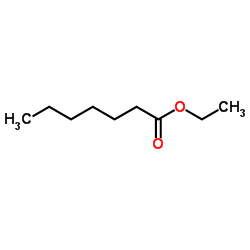Ethyl heptanoate

Ethyl heptanoate structure
|
Common Name | Ethyl heptanoate | ||
|---|---|---|---|---|
| CAS Number | 106-30-9 | Molecular Weight | 158.238 | |
| Density | 0.9±0.1 g/cm3 | Boiling Point | 188.3±3.0 °C at 760 mmHg | |
| Molecular Formula | C9H18O2 | Melting Point | −66 °C(lit.) | |
| MSDS | Chinese USA | Flash Point | 66.1±0.0 °C | |
|
Effects of droplet crystallization and melting on the aroma release properties of a model oil-in-water emulsion.
J. Agric. Food Chem. 54(5) , 1829-37, (2006) Aroma compounds partition between the dispersed and the continuous phases in emulsions, and phase transitions in the lipid droplets profoundly affect the position of the equilibrium. In the present study, the release of ethyl butyrate, ethyl pentanoate, ethyl... |
|
|
Influence of poly (lactide-co-glycolide) type and gamma irradiation on the betamethasone acetate release from the in situ forming systems.
Curr. Drug Deliv. 6(2) , 184-91, (2009) In situ forming biodegradable polymeric systems were prepared from Poly (DL-lactide-co-glycolide), RG504H (50:50, lactide:glycolide), RG756 (75:25) and mixture of them. They were dissolved in N-methyl-2-pyrrolidone (33% w/w) and mixed with betamethasone aceta... |
|
|
Identification of electrophysiologically-active compounds for the malaria mosquito, Anopheles gambiae, in human sweat extracts.
Med. Vet. Entomol. 10(3) , 269-76, (1996) Human sweat samples were chemically fractionated into acid and non-acid components. The most abundant volatile compounds present in the fractions were identified by linked gas chromatography mass spectrometry. The acid fractions were found to be composed of a... |
|
|
Monographs on fragrance raw materials.
Food Cosmet. Toxicol. 19(2) , 237-54, (1981)
|
|
|
Odor detection of single chemicals and binary mixtures.
Behav. Brain Res. 156(1) , 115-23, (2005) The investigation explored the olfactory detectability of two chemically and structurally similar esters, ethyl propanoate and ethyl heptanoate, presented singly and in mixtures. Initially, we measured concentration-detection (i.e., psychometric) functions fo... |
|
|
Chemosensory additivity in trigeminal chemoreception as reflected by detection of mixtures.
Exp. Brain Res. 158(2) , 196-206, (2004) A series of experiments probed into the degree of chemosensory detection additivity exhibited by mixtures of ethyl propanoate and heptanoate in terms of their trigeminal detectability via nasal pungency (i.e., irritation) and eye irritation. Nasal pungency wa... |
|
|
Transfer hydrogenation of olefins catalysed by nickel nanoparticles. Alonso F, et al.
Tetrahedron 65(51) , 10637-10643, (2009)
|